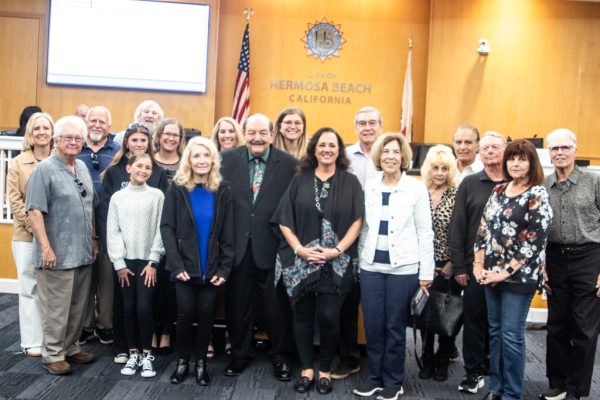
Our South Bay is a photographic panorama of the Beach Cities
It wasn’t long ago, in 2012, that John Post published a book of his photographs to commemorate the Manhattan Beach centennial. The John Post Gallery has been a staple of downtown Manhattan Beach for many years and it’s a safe guess that very few people of Post’s caliber have taken note of the city’s physical growth and changes as closely as he has. The book, by the way, was nicely received.
Afterwards, Post says, “People asked me how come I didn’t do Hermosa. Well… it wasn’t Hermosa’s centennial.”
Which probably got him thinking about the larger picture, in every sense of the word.
“So in 2013 I decided to do a South Bay book. These books take anywhere from two to three years, and three months, no matter what the book is.”
The “three months” part seems puzzling at first, until one realizes it’s the two to three years that contains all the groundwork. “Until you make the commitment, it’s all in your head and some notes on paper. Then it’s crunch time; then you’ve got to come through.”

Postmodern, of course

“The original thought was Our South Bay,” Post says. “But the trick is always what do you leave in and what do you leave out? Do you put in every street corner in town? It kept narrowing itself down until finally it became the coastline, strictly the coastline.”
And so, within 100 pages, Post has given us his best images of five different cities, beginning with El Segundo to the north and curving down around the Peninsula to the south. Not surprisingly, the bulk of the work focuses on Hermosa, Manhattan, and Redondo Beach (Torrance is represented only by a sliver of sand called Rat Beach). Also not surprisingly, the ocean seems to be present even when it’s not in the frame.
Post explains his approach, his basic philosophy, when it comes to hefting a camera and venturing outdoors:
“I rarely shoot a photograph for myself; all my photographs I take for the viewer. I get to have the experience. As I’ve told people over the years, if I wasn’t a photographer I probably wouldn’t even have a camera. It’s too much work. But I take my pictures to capture the moment for other people to experience who don’t have the chance to have that experience, whatever that image may be.
“So, to go back to the book, it’s about sharing. Sharing where we live with the residents.”
It may seem like an easy enough endeavor, as if any shutterbug with a couple of weeks on their hands could go out and get enough shots of the beach cities for a book, but we need to remember that John Post has been making images of the area for 40 years. These pictures are culled from the best of the best.
“I believe it’s the first book of its kind,” Post says, at the same time not failing to mention Robi Hutas, whom Post feels was the original trailblazer. Hutas has been documenting the South Bay in pictures since the 1950s.
“I consider myself the first one to document the beach as art,” Post continues, in contrast with Hutas whose pictures range from the Redondo Beach waterfront (before the city ruined it) to nearly every major volleyball tournament in Hermosa Beach. Another difference is that the vast majority of what Hutas photographed was in black and white whereas with Post it’s pretty much all color, and usually a vibrant color at that.
For our children’s children’s children
Another reason for Our South Bay, Post says, is for the sake of posterity, and not just so that we will be able to recall the various buildings and opens spaces that define the look of an area. At the end of the book are several pages in small print containing the names of current residents — those who responded to ads and announcements to submit their own names and sometimes those of family members. There’s a reason why this was important.
“We always see photographs of our times accompanied by the names of city officials,” Post says. “Rarely if ever are photographs of an area (accompanied) by the names of the average citizens who make up the communities. I wanted this book to contain a record of those people.”
Kind of like the Titanic, I reply, kidding him. You’ll have the passenger list; ‘cause we’re all going down with the big ship, right?
Post laughs. “I think it’ll be more like Carnival Cruises, sailing off into the sunset.”
The ever-changing landscape
Although it never enters the book, there’s an underlying theme that those who leaf through Our South Bay may not even notice and that’s the issue of gentrification or, less politically charged, the simple fact of change. I’m not so sure that Post was eager to discuss this, because his pictures — with very little text; only a short introduction — bypass the subject altogether. And yet what we see is always accompanied by what we don’t see. The past nips at our heels no less than the future.
But of course Post has been around long enough to witness firsthand how the cities around us have grown and grown.
“This might be the first and only book to document the beaches and the coastline before they go Miami Beach,” he says with a grin. In particular, he mentions the AES Power Plant in Redondo Beach, the site of which will one day be quite different and, you can count on it, anything but open land.
This is yet one more reason why Our South Bay is important as a visual document of the area. Who hasn’t come upon a suddenly vacant lot and then wondered what had been there? “These things just disappear,” Post says, “and you can’t go back.
“They’re always trying to keep the small town atmosphere,” he adds, “but that train left in the ‘90s, after the first home went for over $5 million. They want to keep the symbols, but they want everything that made the symbols gone.” That also includes former residents. “The people who made the place can’t afford to live here.”
As mentioned, that’s not really what the book is about, although the topic sits quietly in the background of every page. Also, the photos are aesthetically pleasing and uplifting for the most part, paradise on parade, with no drunks stumbling out of bars or people scrounging through recycling bins. That’s a series for someone else with a different purpose and sensibility.
What John Post has set out to do is give us a bit of permanence between cardboard covers, the Beach Cities preserved.
“This book,” he says, “is not a cell phone, not a selfie, not a moment you can tweet and be done with it forever. This is hard copy. This is not something you keep on your phone and thumb and thumb and thumb and waste time. This is something to take you away from the cell phone, to take you away from digital entrapments.”
Post gestures to the large format photographs on the walls around him. “Drama is in the detail,” he says and he points out the detail in his work. “Too many pictures nowadays focus on the drama and not the detail and as soon as you look beyond the drama the picture’s just an average picture.”
John Post makes photographs that tell us, and will tell those who come after us, who we were and where we lived. His new book is a vital document of the Beach Cities as they exist now, today, before the last Carnival Cruise sails into the sunset.
Our South Bay (100 pp., 114 full-color photographs) is available online at Johnpost.com, by phone (310) 376-6982, or by email John@JohnPost.com. The current price is $109. The John Post Gallery is located at 808 Manhattan Ave., Manhattan Beach. Hours, Wednesday through Sunday from 12 noon to 6 p.m.
[Click any image to see a full screen gallery]
no images were found










